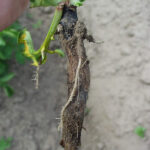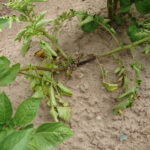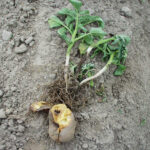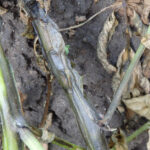Polish name: Black leg
English name: Blackleg
EPPO code: ERWIAT, ERWICA, ERWICH
Perpetrators of the disease:
- Pectobacterium atrosepticum bacteria (syn. Erwinia carotovora subsp. atroseptica), EPPO code: ERWIAT
- Pectobacterium carotovorum subsp. carotovorum (syn. Erwinia carotovora subsp. carotovora), EPPO code: ERWICA
- Dickeya spp. bacteria (including D. dianthicola, D. dadantii, D.zea) (syn. Erwinia chrysanthemi), EPPO code: ERWICH
Gallery

Black leg. The development of infection from diseased seed potatoes
(fot. J. Osowski)
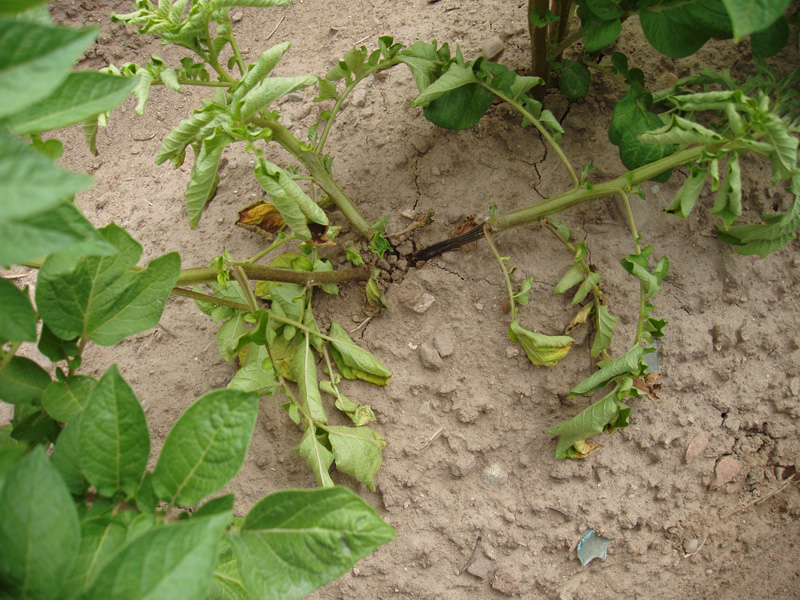
Black leg. The development of infection from diseased seed potatoes
(fot. J. Osowski)
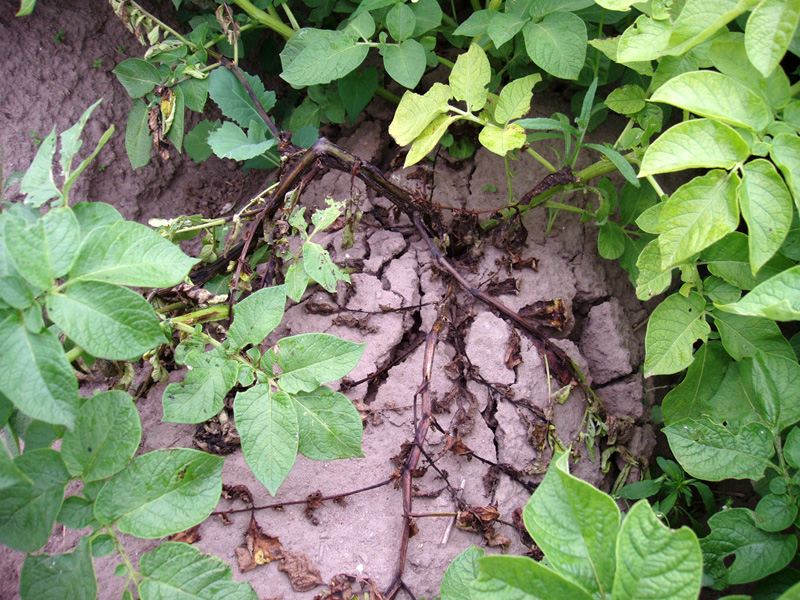
Black leg. Characteristic appearance of heavily infested stems
(fot. J. Osowski)
- Czarna nóżka. Silnie porażone łodygi dają się łatwo wyciągnąć z gleby (fot. S. Wróbel)
- Czarna nóżka. Charakterystyczny wygląd silnie porażonych łodyg (fot. J. Osowski)
- Czarna nóżka. Rozwój infekcji z chorych sadzeniaków (fot. J. Osowski)2
- Czarna nóżka. Rozwój infekcji z chorych sadzeniaków (fot. J. Osowski)
- Czarna nóżka. Typowe objawy na zainfekowanych łodygach (fot. J. Osowski)
- Czarna nóżka. Charakterystyczny wygląd rośliny z objawami choroby (fot. J. Osowski)
Characteristics and description of the disease
The black leg is more severe in years with high rainfall during the growing season or on wet, compact soils.
The culprits of the black leg, a disease occurring on potato stalks, are bacteria of the genus Pectobacterium spp .: Pectobacterium atrosepticum – the main culprit in our climate, Erwinia carotovorum ssp. Carotovorum – a sporadic culprit of the black leg and Dickeya spp. – the culprit of the disease at higher temperatures.
All species of bacteria may not support the emergence of the seed potato from the soil. The original salesmen in the control room, monitoring the facility with a crush, are primarily computer-based, and more specifically for supervision. The bacteria may or may appear on the surface of the tubers inside them. Infection of seed potatoes is not always the case with the naked eye, as the bacteria may remain asymptomatic in the infected tuber as the so-called latent or latent infection. Bacteria that have passed from the mother tuber to the stem, directly infect the plant that has grown out of it. They also infect daughter tubers by wandering through stolons.
In favorable conditions, which they love (high location and temperature 18-19 ° C), latent painting, the mother tubers can quickly turn into nokremowa, soft, rolling, rolling, smelly, foul-rolling. Next, disconnects, disconnects, disconnects, disconnects, disconnects, disconnects, disconnects, disconnects, disconnects, disconnects, disconnects, disconnects, disconnectors
Bacteria from diseased seed potatoes, released into the soil after their decay, can multiply and persist throughout the growing season in the soil in the rhizosphere of host plants or some weeds. The survival of bacteria in moist soil ranges from several days to several months, depending on the weather conditions. It is greater in cool and humid conditions than in warm and dry conditions.
The black leg can also be caused by bacteria transferred by some insects from rotting tubers, from unprotected waste piles, left after spring sorting at storage facilities or uncovered mounds. In the later growing season, especially with higher amounts of rainfall, secondary infections of potatoes on plantations are caused by bacteria also carried by insects from diseased plants growing on the plantation or left in the ridges after negative selection. Symptoms of the disease then occur mainly in the higher parts of the stem, next to the healthy epiphyseal part.
Young plants attacked by the disease usually die without producing a crop. however, they are a dangerous source of bacteria. Older plants produce a crop that is mostly already infected with bacteria, although often in a latent (latent) form.
Symptoms of paralysis
Plants infected with the black leg are stunted. They are stunted, clearly smaller than healthy ones, with light green or yellowish leaves (photo 1). The leaves, especially the upper ones, are protruding, sometimes curling at the edges in a spoon-like shape. Unlike viral infections, the leaves remain soft. They can also wilt and fall off.
Dark brown or completely black shiny wet spots are typical symptoms of a black leg on infected stems (Photo 2). With infections progressing from sick seed potatoes, rot is visible at the base of the affected stems (photos 3A, 3B). On the cross-section of the infected stems, changes in the color of the conductive bundles and sometimes also of the parenchyma, which take various shades of brown, are observed. When crushed, the stalk gives off a characteristic, foul odor. Infested potato shoots break just above the surface of the ridges (photo 4) and can be easily pulled out of the soil (photos 5A, 5B). Under drought conditions, the infected tissues are dry and dry completely (Photo 6). Often, symptoms are limited to the underground part of the stem.
Blackleg symptoms in the form of typical black, damp-soaked spots are usually seen in the upper parts of the plant with external infections. Insect-borne bacteria can infect stems, petioles, and sometimes leaves, most often through minor damage to plants caused by hail or wind.
Protection methods
Reducing the occurrence of the black leg in the potato plantation consists in using proper crop rotation, using healthy seed potatoes, removing the sources of infection from the field, and using the resistance of varieties.
Most of the economically important bacterial culprits of potato diseases are transmitted to the next season by tubers (black leg and wet rot). A healthy seed potato is therefore an essential element in cultivation and is one way of eliminating the primary source of many diseases or reducing the infectious potential of pathogens in the environment.
An important, secondary source of bacterial diseases appearing in potato plantations are also sprouting diseased tubers from waste heaps. Waste tubers should be protected against sprouting and the spread of diseases.
Negative selection, consisting in the careful and timely removal of black leg infected plants during the growing season, is another element in the elimination of the sources of infection. Removal of infected plants from the plantation has a positive effect on its health. The first negative selection should be made when the potato plants reach a height of 20-25 cm, the next one – about 2 weeks later. Sick plants should be removed from the field, as left in ridges, they are a source of infection for healthy plants.
In regions with a high risk of disease, it is also important to select varieties with increased resistance. Unfortunately, there are no chemicals to completely eradicate the disease. Copper fungicides may partially limit its development.
Compiled by: prof. dr hab. Józef Kaps

